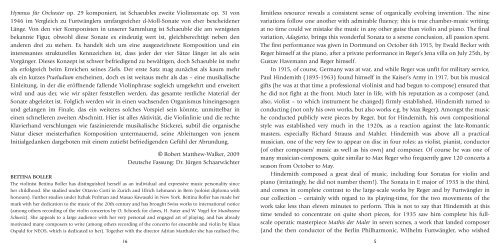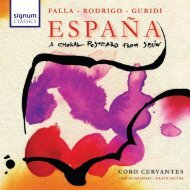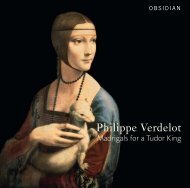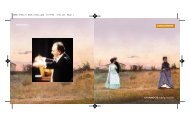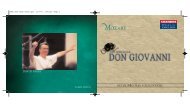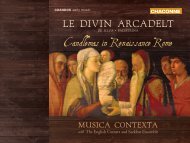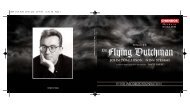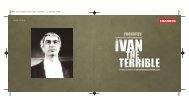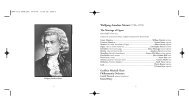Reger himself was well aware of his approach to tonality, which he discussed – thoughin a comparatively short form, in his textbook Supplement to the Theory of Modulation,translated by John Bernhoff and published in 1904. Curiously, Reger wrote to his friendKarl Straube, ‘[with this work] now begins the free, Jena style in Reger.’ With this he meantmore than only a stylistic change – he also related to his house-move to his first villa ofhis own in Jena in April 1915 and to his first period as an independent musician afterhis employment as music director of the Meiningen court orchestra; these were reasonswhy Reger discribed himself ambiguously as a ‘Freiherr’ (baron). The style in this work iscertainly ‘freer’ than he was wont to employ, in that his approach to structure and tonalrelationships marked not so much sudden changes of direction but had evolved to whathas been well described (by William E Grim) as ‘a settled maturity’ with regard to theorganic structural cohesion of the work in question.We can certainly discover that aspect of Reger’s in the C minor Violin Sonata, althoughthe emotional aspect of the music – especially in the first movement – is anything butsettled, as we may see from the tempo indication, Con passione. But this is not wholly true ofthe movement for the opening idea is soon contrasted with a very different second theme;the passion returns, and the music oscillates this way and that, constantly shifting until themore eruptive first theme appears to have the last word. In the second movement, Largo,it is the more lyrical mood (as we might expect) that carries the main emotional basis ofthe music. Although a climax is reached, it does not wholly disturb the underlying senseof repose which returns more settled than before. The Scherzo, in a gentle 3/4 pulse, isequally free from passion, in the purely emotive sense. It is a delicately-scored dance-likemovement that recalls aspects of Reger’s Ballett-Suite for orchestra, Opus 130, contrastedwith a somewhat slower, lyrical idea; music whose emotion is very directly expressed,before the dance returns, almost coquettish in character.The theme which forms the basis for the variations of the finale returns us to the‘settled maturity’ of which William Grim wrote. At first, the theme appears almost tooself-contained to permit wide variation, but as the music unfolds, the composer’s almostpartly internationally award-winning, music visualisations. Together with her duo partner Walter Prossnitz sheattends to many other works beyond the established repertoire. She also has a special interest in contemporarycreative musical work. She is a member of the soloist ensemble Collegium Novum Zurich, and together withpianist Stefka Perifanova and cellist Imke Frank founded the Absolut Trio, which has made a name for itselfwith its special programmes and commissions for theme-related compositions on a yearly basis. In 2006, e.g.,two works were created, which referred to Schumann’s vocal duets (Junghae Lee, Gary Berger). In the summerof 2008 the Trio’s debut CD (GMCD 7322) was published with works by A. Schoenberg (“Verklärte Nacht”arranged by E. Steuermann for piano trio), “15 Moments Musicaux” by Rudolf Kelterborn, dedicated to theAbsolut Trio, and B.A. Zimmermann’s “Présence”. An additional important personal interest for Bettina Boller ismusical education for children. She has conceived and executed several projects with orchestra, e.g. most recently“Peer Gynt” for children from the age of 6.For Bettina Boller music is a language, to which she wants to dedicate herself uncompromisingly taking allaspects into account, as a compelling experience for both the audience as well as herself.Die Geigerin Bettina Boller hat sich seit ihrer Kindheit als eigenwillige und ausdrucksstarke Musikerpersönlichkeitprofiliert. Ausbildung bei Ottavio Corti in Zürich und Ulrich Lehmann in Bern (Solistendiplom mitAuszeichnung). Weitere Studien bei Itzhak Perlman und Masao Kawasaki in New York. Bettina Boller hatsich mit ihrem Einsatz für die Musik des 20. Jahrhunderts einen Namen gemacht und Schweizer Werke zuinternationaler Beachtung geführt (u.a. Einspielung der Violinkonzerte von O. Schoeck für Claves, H. Suter undW. Vogel für Musikszene Schweiz). Mit ihrer sehr persönlichen und engagierten Spielkunst spricht sie ein grossesPublikum an und hat schon viele Komponisten zum Schreiben angeregt (u.a. Einspielung des ihr gewidmetenKonzerts für Ensemble und Violine von Klaus Ospald für NEOS). Gemeinsam mit dem Regisseur AdrianMarthaler realisierte sie fünf z.T. international preisgekrönte Musikvisualisierungen. Mit ihrem Duo-PartnerWalter Prossnitz nimmt sie sich v.a. Werken jenseits des gängigen Repertoires an. Ihr besonderes Interesse giltauch dem zeitgenössischen Musikschaffen. Sie ist Mitglied des Solistenensembles Collegium Novum Zürich undgründete gemeinsam mit der Pianistin Stefka Perifanova und der Cellistin Imke Frank das Absolut Trio, welchesmit seinen speziellen Programmen von sich reden macht und alljährlich themenbezogene Kompositionsaufträgevergibt. 2006 entstanden z.B. zwei Werke, welche sich auf Schumanns Vokalduette bezogen (Junghae Lee, GaryBerger). Im Sommer 2008 erschien die Trio Debut-CD (GMCD 7322) mit Werken von A. Schoenberg (VerklärteNacht in der Bearbeitung von E. Steuermann für Klaviertrio), „15 Moments Musicaux“ von Rudolf Kelterborn,dem Absolut Trio gewidmet, und B.A. Zimmermann „Présence“. Ein weiteres wichtiges Anliegen ist für BettinaBoller auch die Musikvermittlung für Kinder. Mehrere Projekte mit Orchester sind von ihr konzipiert unddurchgeführt worden, so zuletzt „Peer Gynt“ für Kinder ab 6 Jahren.4 17
Hymnus für Orchester op. 29 komponiert, ist Schaeubles zweite Violinsonate op. 31 von1946 im Vergleich zu Furtwänglers umfangreicher d-Moll-Sonate von eher bescheidenerLänge. Von den vier Komponisten in unserer Sammlung ist Schaeuble die am wenigstenbekannte Figur, obwohl diese Sonate es eindeutig wert ist, gleichberechtigt neben denanderen drei zu stehen. Es handelt sich um eine ausgezeichnete Komposition und eininteressantes strukturelles Kennzeichen ist, dass jeder der vier Sätze länger ist als seinVorgänger. Dieses Konzept ist schwer befriedigend zu bewältigen, doch Schaeuble ist mehrals erfolgreich beim Erreichen seines Ziels. Der erste Satz mag zunächst als kaum mehrals ein kurzes Praeludium erscheinen, doch es ist weitaus mehr als das – eine musikalischeEinleitung, in der die eröffnende fallende Violinphrase sogleich umgekehrt und erweitertwird und aus der, wie wir später feststellen werden, das gesamte restliche Material derSonate abgeleitet ist. Folglich werden wir in einen wachsenden Organismus hineingesogenund gelangen im Finale, das ein weiteres solches Vorspiel sein könnte, unmittelbar ineinen schnelleren zweiten Abschnitt. Hier ist alles Aktivität, die Violinlinie und die rechteKlavierhand verschlungen wie faszinierende musikalische Stickerei, subtil die organischeNatur dieser meisterhaften Komposition untermauernd, seine Ableitungen von jenemInitialgedanken dargeboten mit einem zutiefst befriedigenden Gefühl der Abrundung.16© Robert Matthew-Walker, 2009Deutsche Fassung: Dr. Jürgen Schaarwächter<strong>BETTINA</strong> <strong>BOLLER</strong>The violinist Bettina Boller has distinguished herself as an individual and expressive music personality sinceher childhood. She studied under Ottavio Corti in Zurich and Ulrich Lehmann in Bern (soloist diploma withhonours). Further studies under Itzhak Perlman and Masao Kawasaki in New York. Bettina Boller has made hermark with her dedication to the music of the 20th century and has brought Swiss works to international notice(among others recording of the violin concertos by O. Schoeck for claves, H. Suter and W. Vogel for MusikszeneSchweiz). She appeals to a large audience with her very personal and engaged art of playing, and has alreadymotivated many composers to write (among others recording of the concerto for ensemble and violin by KlausOspald for NEOS, which is dedicated to her). Together with the director Adrian Marthaler she has realised five,limitless resource reveals a consistent sense of organically evolving invention. The ninevariations follow one another with admirable fluency; this is true chamber-music writing;at no time could we mistake the music in any other guise than violin and piano. The finalvariation, Adagietto, brings this wonderful Sonata to a serene conclusion, all passion spent.The first performance was given in Dortmund on October 6th 1915, by Ewald Becker withReger himself at the piano, after a private performance in Reger’s Jena villa on July 25th, byGustav Havemann and Reger himself.In 1915, of course, Germany was at war, and while Reger was unfit for military service,Paul Hindemith (1895-1963) found himself in the Kaiser’s Army in 1917, but his musicalgifts (he was at that time a professional violinist and had begun to compose) ensured thathe did not fight at the front. Much later in life, with his reputation as a composer (and,also, violist – to which instrument he changed) firmly established, Hindemith turned toconducting (not only his own works, but also works e.g. by Max Reger). Amongst the musiche conducted publicly were pieces by Reger, but for Hindemith, his own compositionalstyle was established very much in the 1920s, as a reaction against the late-Romanticmasters, especially Richard Strauss and Mahler. Hindemith was above all a practicalmusician, one of the very few to appear on disc in four roles: as violist, pianist, conductor(of other composers’ music as well as his own) and composer. Of course he was one ofmany musician-composers, quite similar to Max Reger who frequently gave 120 concerts aseason from October to May.Hindemith composed a great deal of music, including four Sonatas for violin andpiano (irritatingly, he did not number them!). The Sonata in E major of 1935 is the third,and comes in complete contrast to the large-scale works by Reger and by Furtwängler inour collection – certainly with regard to its playing-time, for the two movements of thework take less than eleven minutes to perform. This is not to say that Hindemith at thistime tended to concentrate on quite short pieces, for 1935 saw him complete his fullscaleoperatic masterpiece Mathis der Maler in seven scenes, a work that landed composer(and the then conductor of the Berlin Philharmonic, Wilhelm Furtwängler, who wished5


